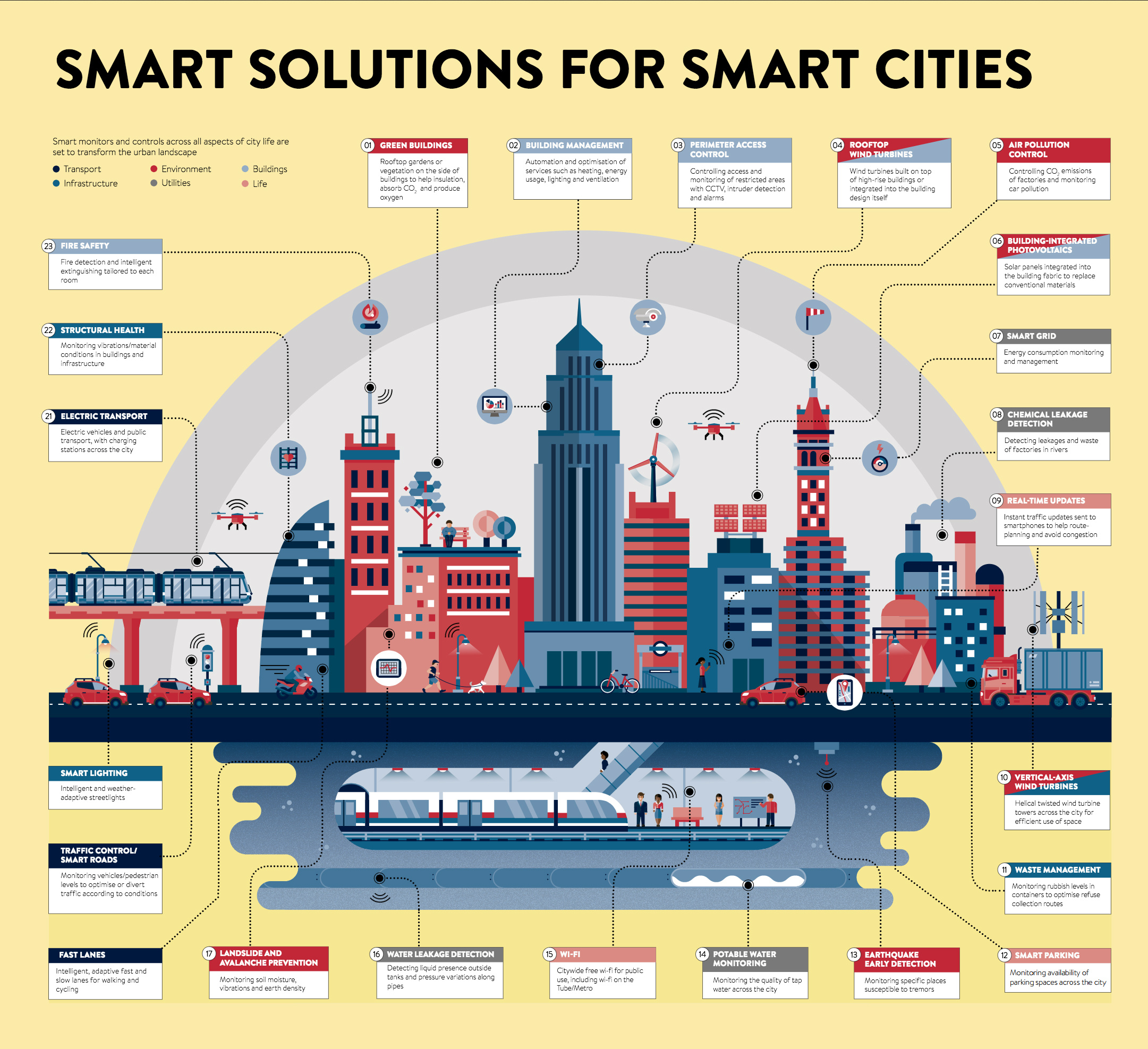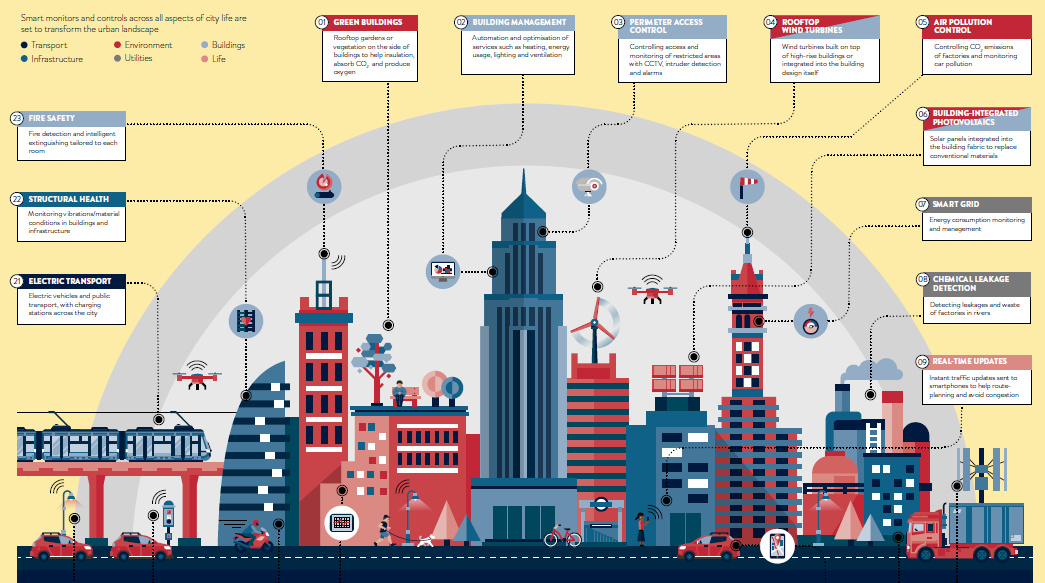Technology
Infographic: The Anatomy of a Smart City

The Anatomy of a Smart City
There is no doubt that the city will be the defining feature of human geography for the 21st century.
Globally, there are 1.3 million people moving to cities each week – and by 2040, a staggering 65% of the world’s population will live in cities.
At the same time, the 600 biggest urban areas already account for 60% of global GDP, and this will only rise higher as cities become larger and more prosperous. In fact, experts estimate that up to 80% of future economic growth in developing regions will occur in cities alone.
The Smart City: A Necessary Step
As cities become an even more important driver of the global economy and wealth, it’s becoming crucial to ensure that they are optimized to maximize efficiency and sustainability, while enhancing the quality of life in each urban conglomeration.
Today’s infographic from Postscapes helps define the need for smart cities, and it also gives great examples of how technology can be applied in urban settings to facilitate cities that work better for their citizens.
Features of Tomorrow’s Cities
Smart cities will use low power sensors, wireless networks, and mobile-based applications to measure and optimize everything within cities.
Here are just some examples: (click below image to open full-size version)
Smart city solutions will fall into six broad categories, transforming the urban landscape:
1. Infrastructure
Smart lighting is one of the most important solutions that will be implemented in citywide infrastructure. While smart lighting sounds trivial at first glance, it’s worth noting that lighting alone consumes a whopping 19% of the world’s total electricity.
2. Buildings
Heating, energy usage, lighting, and ventilation will be managed and optimized by technology. Solar panels will be integrated into building design, replacing traditional materials. Fire detection and extinguishing is tailored to individual rooms.
3. Utilities
Smart grids (used for energy consumption monitoring and management), water leakage detection, and water potability monitoring are just some smart city aspects on the utilities side.
4. Transport
Intelligent, adaptive fast lanes and slow lanes (cycling, walking) will be implemented, while charging stations through the city will power EVs.
5. Environment
Air pollution control, renewable energy, and waste management solutions will make for greener cities. Rooftop gardens or side vegetation will be integrated into building designs, to help with insulation, provide oxygen, and absorb CO2.
6. Life
There will be citywide Wi-Fi for public use, while real-time updates will provide citizens information on traffic congestion, parking spaces, and other city amenities.
The Effect?
Cisco estimates that smarter cities will have impressive increases in efficiency: using many of the above concepts, cities can improve energy efficiency by 30% in 20 years.
Simultaneously, it’s estimated that the broad market for smart cities products and services will be worth $2.57 trillion by 2025, growing at a clip of 18.4% per year on average.
Technology
All of the Grants Given by the U.S. CHIPS Act
Intel, TSMC, and more have received billions in subsidies from the U.S. CHIPS Act in 2024.

All of the Grants Given by the U.S. CHIPS Act
This was originally posted on our Voronoi app. Download the app for free on iOS or Android and discover incredible data-driven charts from a variety of trusted sources.
This visualization shows which companies are receiving grants from the U.S. CHIPS Act, as of April 25, 2024. The CHIPS Act is a federal statute signed into law by President Joe Biden that authorizes $280 billion in new funding to boost domestic research and manufacturing of semiconductors.
The grant amounts visualized in this graphic are intended to accelerate the production of semiconductor fabrication plants (fabs) across the United States.
Data and Company Highlights
The figures we used to create this graphic were collected from a variety of public news sources. The Semiconductor Industry Association (SIA) also maintains a tracker for CHIPS Act recipients, though at the time of writing it does not have the latest details for Micron.
| Company | Federal Grant Amount | Anticipated Investment From Company |
|---|---|---|
| 🇺🇸 Intel | $8,500,000,000 | $100,000,000,000 |
| 🇹🇼 TSMC | $6,600,000,000 | $65,000,000,000 |
| 🇰🇷 Samsung | $6,400,000,000 | $45,000,000,000 |
| 🇺🇸 Micron | $6,100,000,000 | $50,000,000,000 |
| 🇺🇸 GlobalFoundries | $1,500,000,000 | $12,000,000,000 |
| 🇺🇸 Microchip | $162,000,000 | N/A |
| 🇬🇧 BAE Systems | $35,000,000 | N/A |
BAE Systems was not included in the graphic due to size limitations
Intel’s Massive Plans
Intel is receiving the largest share of the pie, with $8.5 billion in grants (plus an additional $11 billion in government loans). This grant accounts for 22% of the CHIPS Act’s total subsidies for chip production.
From Intel’s side, the company is expected to invest $100 billion to construct new fabs in Arizona and Ohio, while modernizing and/or expanding existing fabs in Oregon and New Mexico. Intel could also claim another $25 billion in credits through the U.S. Treasury Department’s Investment Tax Credit.
TSMC Expands its U.S. Presence
TSMC, the world’s largest semiconductor foundry company, is receiving a hefty $6.6 billion to construct a new chip plant with three fabs in Arizona. The Taiwanese chipmaker is expected to invest $65 billion into the project.
The plant’s first fab will be up and running in the first half of 2025, leveraging 4 nm (nanometer) technology. According to TrendForce, the other fabs will produce chips on more advanced 3 nm and 2 nm processes.
The Latest Grant Goes to Micron
Micron, the only U.S.-based manufacturer of memory chips, is set to receive $6.1 billion in grants to support its plans of investing $50 billion through 2030. This investment will be used to construct new fabs in Idaho and New York.
-

 Education1 week ago
Education1 week agoHow Hard Is It to Get Into an Ivy League School?
-

 Technology2 weeks ago
Technology2 weeks agoRanked: Semiconductor Companies by Industry Revenue Share
-

 Markets2 weeks ago
Markets2 weeks agoRanked: The World’s Top Flight Routes, by Revenue
-

 Demographics2 weeks ago
Demographics2 weeks agoPopulation Projections: The World’s 6 Largest Countries in 2075
-

 Markets2 weeks ago
Markets2 weeks agoThe Top 10 States by Real GDP Growth in 2023
-

 Demographics2 weeks ago
Demographics2 weeks agoThe Smallest Gender Wage Gaps in OECD Countries
-

 Economy2 weeks ago
Economy2 weeks agoWhere U.S. Inflation Hit the Hardest in March 2024
-

 Environment2 weeks ago
Environment2 weeks agoTop Countries By Forest Growth Since 2001















